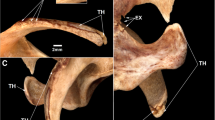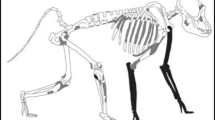Abstract
Pathognomonic metacarpal undermining is a skeletal pathology that has been associated with Mycobacterium tuberculosis in bovids. Postcranial artiodactyl, perissodactyl, and carnivore skeletons were examined in major university and museum collections of North America and Europe for evidence of this and other pathology potentially attributable to tuberculosis. Among nonproboscidean mammals from pre-Holocene North America, bone lesions indicative of tuberculosis were restricted to immigrant bovids from Eurasia. No bone lesions compatible with diagnosis of tuberculosis were found in large samples of other pre-Holocene (164 Oligocene, 397 Miocene, and 1,041 Plio–Pleistocene) North American mammals, including 114 antilocaprids. Given the unchanged frequency of bovid tubercular disease during the Pleistocene, it appears that most did not die from the disease but actually reached an accommodation with it (as did the mastodon) (Rothschild and Laub 2006). Thus, they were sufficiently long-lived to assure greater spread of the disease. The relationships of the proboscidean examples need further study, but present evidence suggests a Holarctic spread of tuberculosis during the Pleistocene, with bovids acting as vectors. While the role of other animals in the transmission of tuberculosis could be considered, the unique accommodation achieved by bovids and mastodons makes them the likely “culprits” in its spread.

Similar content being viewed by others
References
Aceves-Avila FJ, Baez-Molgado S, Medina F, Fraga A (1998) Paleopathology in osseous remains from the XVI century: a survey of rheumatic diseases. J Rheumatol 25:776–782
Allison MJ, Mendoza D, Pezzia A (1973) Documentation of a case of tuberculosis in pre-Columbian America. Am Rev Respir Dis 107:985–991
Aufderheide AC, Rodriguez-Martin C (1998) The Cambridge encyclopedia of human paleopathology. Cambridge University Press, Cambridge, UK
Bartels P (1907) Tuberkulose (Wirbelkaries) in der jungeren Steinzeit. Archiv von Anthropologie 6:243–255
Buikstra JE (1976) The Caribou Eskimo: general and specific disease. Am J Phys Anthropol 45:351–368
Formicola V (1995) X-linked hypophosphatemic rickets: a probable Upper Paleolithic case. Am J Phys Anthropol 98:403–409
Greenblatt CL (1998) Digging for pathogens: ancient emerging diseases—their evolutionary, anthropological and archeological context. Balaban, Jerusalem
Hershkovitz IH, Rothschild BM, Dutour O, Greenwald C (1998) Clues to recognition of fungal origin of lytic skeletal lesions. Am J Phys Anthropol 106:47–60
Hong SH, Kim SM, Ahn JM, Chung HW, Shin MJ, Kang HS (2001) Tuberculosis versus pyogenic arthritis: MR imaging evaluation. Radiology 218:848–853
Kolman CJ, Tuross N (2000) Ancient DNA analysis of human populations. Am J Phys Anthropol 111:5–23
Kolman CJ, Centurion-Lara A, Lukehart SA, Owsley DW, Tuross DW (2000) Identification of Treponema pallidum subspecies pallidum in a 200-year-old skeletal specimen. J Infect Dis 180:2060–2063
Martin LD, Rothschild BM (1989) Frequency of pathology in a large natural sample from Natural Trap Cave (late Pleistocene). J Vertebr Paleontol 9:31A
Morse D (1967) Tuberculosis. In: Brothwell D, Sandison AT (eds) Diseases in antiquity. Charles C. Thomas, Springfield, Illinois, pp 249–271
Palfi G (1991) The osteo-archaeological evidence of vertebral tuberculosis in the 8th century. Acta Biologica Szeged 37:101–105
Resnick D (2002) Diagnosis of bone and joint disorders, 4th edn. Saunders, Philadelphia, PA
Rothschild BM, Helbling M II (2001) Documentation of hyperdisease in the Late Pleistocene: validation of an early 20th century hypothesis. J Vertebr Paleontol 21:94A
Rothschild BM, Laub R (2006) Hyperdisease in the Late Pleistocene: validation of an early 20th century hypothesis. Naturwissenschaften (in press)
Rothschild BM, Martin LD (1993) Paleopathology: disease in the fossil record. CRC Press, London
Rothschild BM, Martin LD (2003) Frequency of pathology in a large natural sample from Natural Trap Cave with special remarks on erosive disease in the Pleistocene. Rheumatismo 55:58–65
Rothschild BM, Martin LD, Lev G, Bercovier H, Bar-Gal GK, Greenblatt C, Donoghue H, Spigelman M, Brittain D (2001) Mycobacterium-tuberculosis-complex DNA from an extinct bison dated 17,000 years. Clin Infect Dis 33:305–311
Rothschild BM, Rothschild C, Helbling M (2003) Unified theory of the origins of erosive arthritis: conditioning as a protective/directing mechanism. J Rheumatol 30:2095–2102
Sager P, Schalimtzek M, Moller-Christensen V (1972) A case of spondylitis tuberculosa in the Danish Neolithic age. Dan Med Bull 19:176–180
Salo WL, Aufderheide AC, Buikstra J, Holcomb TA (1994) Identification of Mycobacterium tuberculosis DNA in a pre-Columbian Peruvian mummy. Proc Natl Acad Sci USA 91:2091–2094
Vaughan TA (1978) Mammology. Saunders, Philadelphia, PA
Verano JW, Ubelaker DH (1992) Disease and demography in the Americas. Smithsonian Institution, Washington, DC
Wang X, Martin LD (1993) Natural Trap Cave. Natl Geographic Soc Res Rep 9:422
Wells C (1964) Bones, bodies and diseases. Thames and Hudson, London
Widmer L, Perzigian AJ (1981) The ecology and etiology of skeletal lesions in late prehistoric populations from eastern North America. Northwestern Univ Archeol Prog Sci Papers 5:99–113
Zimmerman MR (1979) Pulmonary and osseous tuberculosis in an Egyptian mummy. Bull NY Acad Med 55:604–608
Acknowledgments
Appreciation is expressed to George Corner, Mike Voorhees, R. Tedford, George Culver, Mark Franks, Michael Webb, Gregg Gunnell, Ivor Harkin, Paddy O’Sullivan, Pat Holroyd, Chatterjee, Pamela Owen, Wann Langston Jr., and Jeff Saunders. John J. Chiment provided specimens and valuable information about bovid locales.
Author information
Authors and Affiliations
Corresponding author
Rights and permissions
About this article
Cite this article
Rothschild, B.M., Martin, L.D. Did ice-age bovids spread tuberculosis?. Naturwissenschaften 93, 565–569 (2006). https://doi.org/10.1007/s00114-006-0145-7
Received:
Revised:
Accepted:
Published:
Issue Date:
DOI: https://doi.org/10.1007/s00114-006-0145-7




